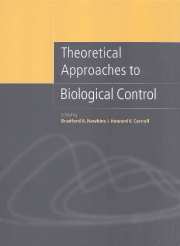Book contents
- Frontmatter
- Contents
- List of contributors
- Preface
- Part I Biological control theory: past and present
- Part II Ecological considerations
- Part III Spatial considerations
- Part IV Genetic/evolutionary considerations
- 13 Population dynamics and the evolutionary stability of biological control
- 14 Genetic conflict in natural enemies: a review, and consequences for the biological control of arthropods
- 15 The evolution of overexploitation and mutualism in plant–herbivore–predator interactions and its impact on population dynamics
- 16 A Darwinian view of host selection and its practical implications
- Part V Microbes and pathogens
- Index
13 - Population dynamics and the evolutionary stability of biological control
from Part IV - Genetic/evolutionary considerations
Published online by Cambridge University Press: 13 August 2009
- Frontmatter
- Contents
- List of contributors
- Preface
- Part I Biological control theory: past and present
- Part II Ecological considerations
- Part III Spatial considerations
- Part IV Genetic/evolutionary considerations
- 13 Population dynamics and the evolutionary stability of biological control
- 14 Genetic conflict in natural enemies: a review, and consequences for the biological control of arthropods
- 15 The evolution of overexploitation and mutualism in plant–herbivore–predator interactions and its impact on population dynamics
- 16 A Darwinian view of host selection and its practical implications
- Part V Microbes and pathogens
- Index
Summary
Introduction
An appealing feature of classical biological control is that it has the potential to be self-sustaining, following initial establishment of the control agent, without the need for perpetual, large-scale human intervention. Most theoretical studies relevant to biological control (as in many chapters in this volume) explore population dynamics, making the quite reasonable assumption that basic biological properties of pest species and control agents are constant. Yet, over sufficiently long time-scales, neither target pests nor control agents are likely to have fixed properties. A truism of evolutionary biology is that all species harbor genetic variation for most characters (Lewontin, 1974) and so can respond via changes in genetic composition to environmental change. Introducing a biological control agent that limits pest numbers below economically significant levels surely counts as a significant environmental change, one that might be expected to have the potential to evoke an evolutionary response in the target pest species. This raises the question of what circumstances foster sustained biological control over evolutionary time-scales. Given strong selection, evolutionary time-scales permitting substantial changes in traits relevant to biological control could well be of the order of years or tens of years, not eons, given the high potential growth rates and population sizes, and short generation times, of many insect species. We suggest that the best biological control is that which can be evolutionarily stable, as well as ecologically persistent, and that a useful role of theory is to clarify when such evolutionary stability might be expected.
- Type
- Chapter
- Information
- Theoretical Approaches to Biological Control , pp. 219 - 230Publisher: Cambridge University PressPrint publication year: 1999
- 3
- Cited by



